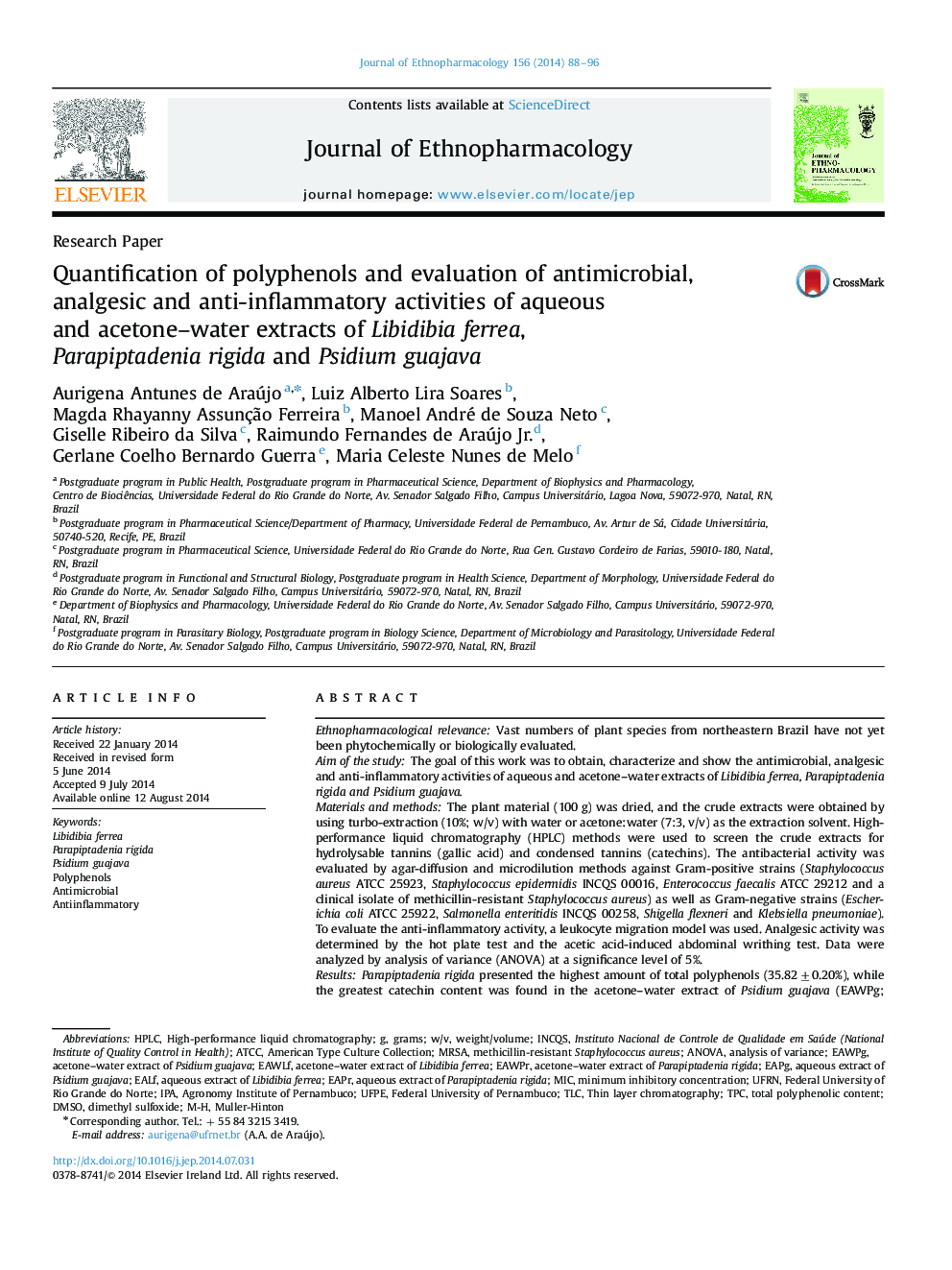| کد مقاله | کد نشریه | سال انتشار | مقاله انگلیسی | نسخه تمام متن |
|---|---|---|---|---|
| 2545245 | 1560405 | 2014 | 9 صفحه PDF | دانلود رایگان |

Ethnopharmacological relevanceVast numbers of plant species from northeastern Brazil have not yet been phytochemically or biologically evaluated.Aim of the studyThe goal of this work was to obtain, characterize and show the antimicrobial, analgesic and anti-inflammatory activities of aqueous and acetone–water extracts of Libidibia ferrea, Parapiptadenia rigida and Psidium guajava.Materials and methodsThe plant material (100 g) was dried, and the crude extracts were obtained by using turbo-extraction (10%; w/v) with water or acetone:water (7:3, v/v) as the extraction solvent. High-performance liquid chromatography (HPLC) methods were used to screen the crude extracts for hydrolysable tannins (gallic acid) and condensed tannins (catechins). The antibacterial activity was evaluated by agar-diffusion and microdilution methods against Gram-positive strains (Staphylococcus aureus ATCC 25923, Staphylococcus epidermidis INCQS 00016, Enterococcus faecalis ATCC 29212 and a clinical isolate of methicillin-resistant Staphylococcus aureus) as well as Gram-negative strains (Escherichia coli ATCC 25922, Salmonella enteritidis INCQS 00258, Shigella flexneri and Klebsiella pneumoniae). To evaluate the anti-inflammatory activity, a leukocyte migration model was used. Analgesic activity was determined by the hot plate test and the acetic acid-induced abdominal writhing test. Data were analyzed by analysis of variance (ANOVA) at a significance level of 5%.ResultsParapiptadenia rigida presented the highest amount of total polyphenols (35.82±0.20%), while the greatest catechin content was found in the acetone–water extract of Psidium guajava (EAWPg; 1.04 μg/g). The largest amounts of catechins were found in the aqueous extract of Libidibia ferrea (EALf; 1.07 μg/g) and the acetone–water extract of Parapiptadenia rigida (EAWPr; 1.0 μg/g). All extracts showed activity against Gram-positive bacteria. The aqueous and acetone–water extracts of Psidium guajava showed the greatest inhibition zones in the agar diffusion tests. In the evaluation of the minimum inhibitory concentration (MIC), the most susceptible Gram-positive bacterium was Staphylococcus epidermidis and the most susceptible Gram-negative bacterium was Shigella flexneri. EAPg and EAWPg showed the greatest MIC values. All extracts were significant inhibitors of leukocyte migration (p<0.05). Using the writhing test, significant analgesic activity was found for EAPr (50 mg/kg), EAWPr (100 mg/kg and 200 mg/kg) and EAWPg (50 mg/kg) (p<0.05).ConclusionsThus, the appropriate extraction procedure preserves the chemical components such as gallic acid and catechin, and showed antimicrobial, anti-inflammatory and analgesic properties.
Figure optionsDownload high-quality image (200 K)Download as PowerPoint slide
Journal: Journal of Ethnopharmacology - Volume 156, 28 October 2014, Pages 88–96